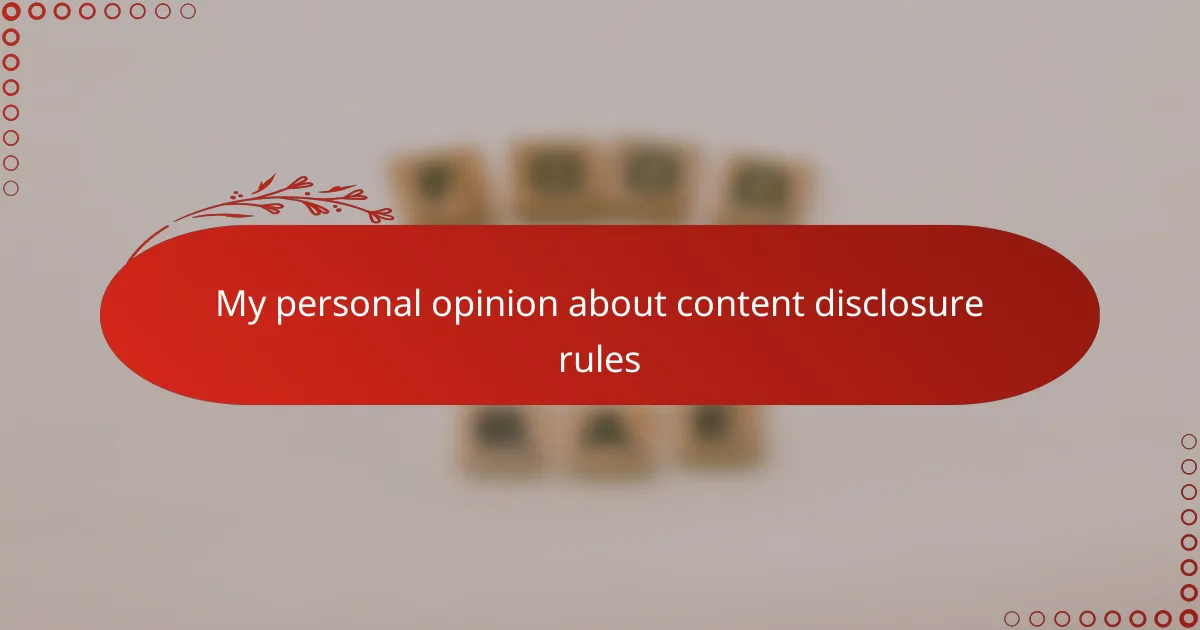Key takeaways
- Content disclosure rules are essential for maintaining trust and transparency between broadcasters and listeners, ensuring clarity about the nature of the content.
- Effective disclosure methods include clear verbal cues and integrating messages within the programming, enhancing listener engagement without interrupting the flow.
- Challenges include varying interpretations of rules across stations and the difficulty of timing disclosures during live broadcasts.
- Continuous training for broadcasters and the standardization of disclosure language can improve compliance and strengthen audience trust.
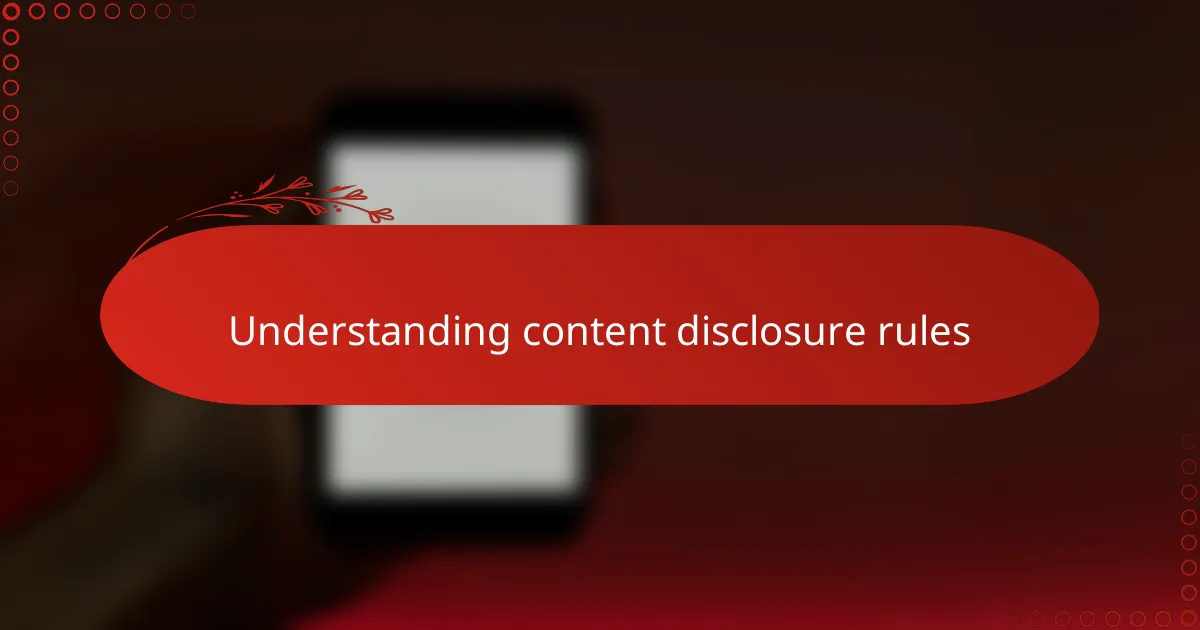
Understanding content disclosure rules
When it comes to content disclosure rules in radio broadcasting, I’ve found that clarity is everything. These rules require broadcasters to be transparent about the nature and source of their content, ensuring listeners know whether what they hear is paid, sponsored, or editorial. I remember early in my career feeling puzzled about where to draw the line—what exactly had to be disclosed and when.
Have you ever wondered why some ads blend so seamlessly into regular programming that it’s hard to tell the difference? That’s precisely why content disclosure exists: to maintain trust with the audience. From my experience, following these rules isn’t just about compliance; it’s about showing respect for listeners and valuing their right to know what’s influencing the broadcast.
Understanding these rules can feel like navigating a tricky path, especially when creativity meets regulation. But once you get the hang of it, disclosure becomes a tool—not a hurdle—that adds authenticity to your show. It’s like inviting listeners behind the scenes and saying, “Here’s what’s really happening.” That honesty can deepen the connection far beyond just the airwaves.
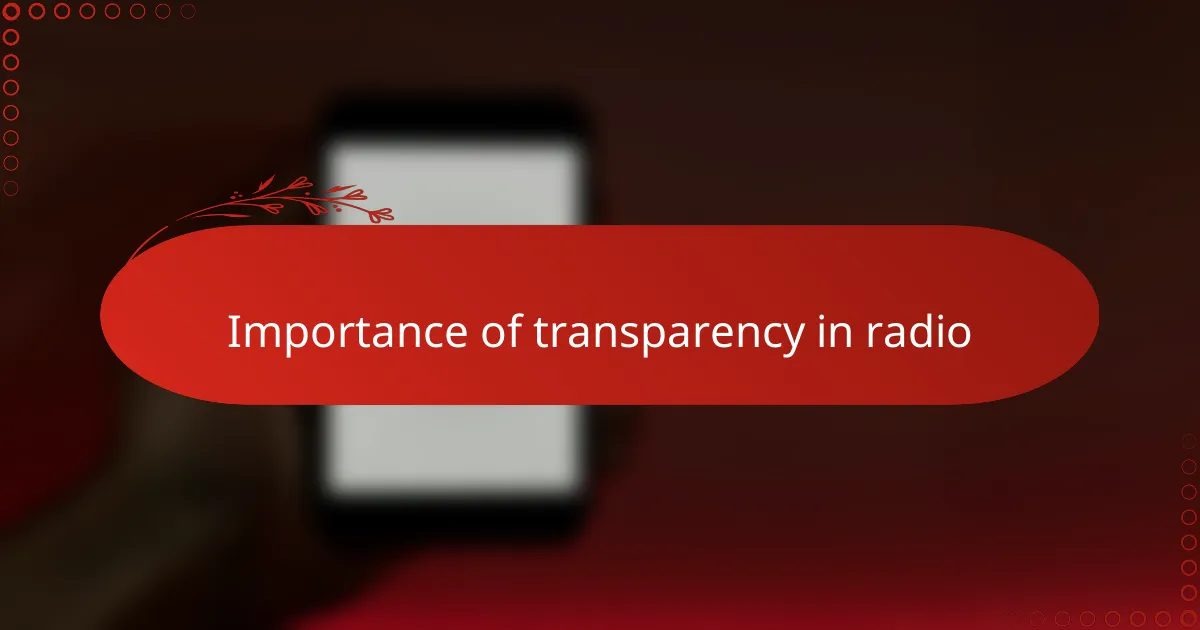
Importance of transparency in radio
Transparency in radio isn’t just a rule—it’s a bridge between the broadcaster and the listener. I’ve noticed that when a show is upfront about its content sources, it builds a sense of trust that feels almost personal. After all, wouldn’t you want to know if what you’re hearing is someone else’s voice or a genuine expression from the host?
Sometimes, I reflect on how transparency can transform a simple broadcast into a shared experience. When you disclose clearly, listeners don’t just hear sounds; they feel included in the process. That kind of openness invites engagement and loyalty in a way that hidden agendas never could.
Have you ever felt betrayed when an ad suddenly popped up disguised as part of the program? That sneaky feeling sticks with you. From my perspective, transparency protects everyone—it respects the audience’s intelligence and affirms the broadcaster’s integrity.
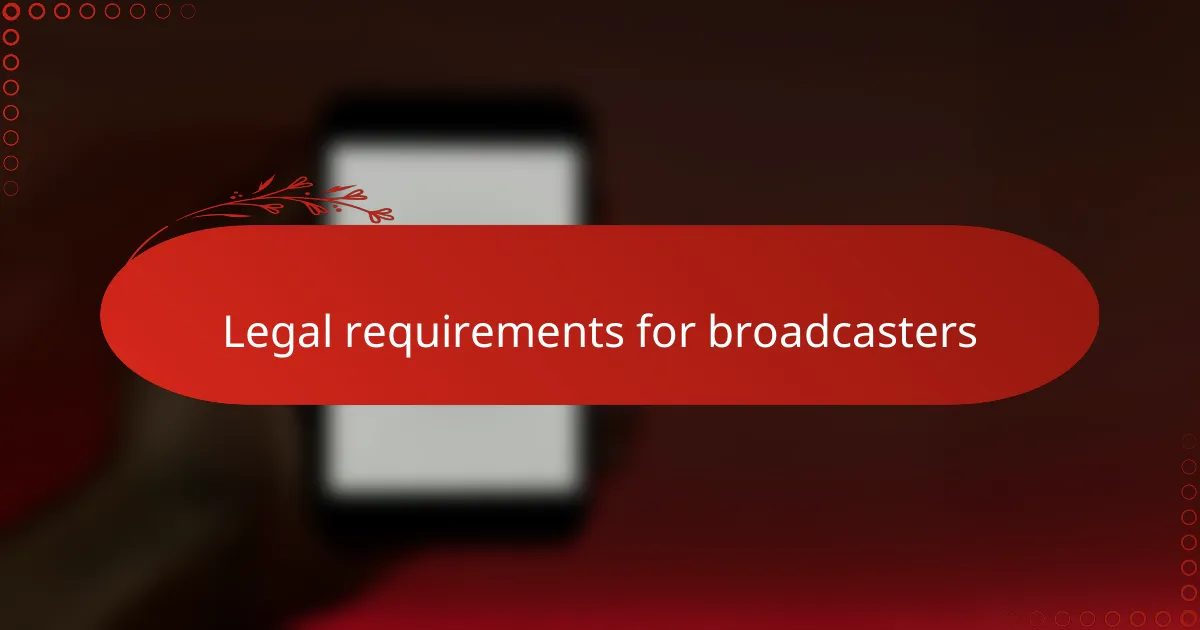
Legal requirements for broadcasters
Legal requirements for broadcasters are not just paperwork; they form the backbone of ethical radio. I remember struggling with the specific mandates on disclosing sponsored content early on—it felt like walking a tightrope between creativity and compliance. Have you ever wondered why regulators emphasize clearly marking paid content? It’s all about preventing deception and protecting listeners’ trust.
The law demands timely and conspicuous disclosures, which means broadcasters can’t tuck a sponsorship notice away in fine print or whisper it quickly. From my experience, meeting these requirements isn’t restrictive—it actually sharpens your awareness and respect for the audience. When these rules are followed well, they keep the broadcasting ecosystem fair and transparent for everyone involved.
Sometimes, I think these legal requirements even nudge broadcasters toward higher standards of honesty. Would you want to tune in to a station that skirts these rules? Probably not. Observing them shows listeners that you value their right to know exactly what influences the content they receive, reinforcing the personal connection we all strive for on air.
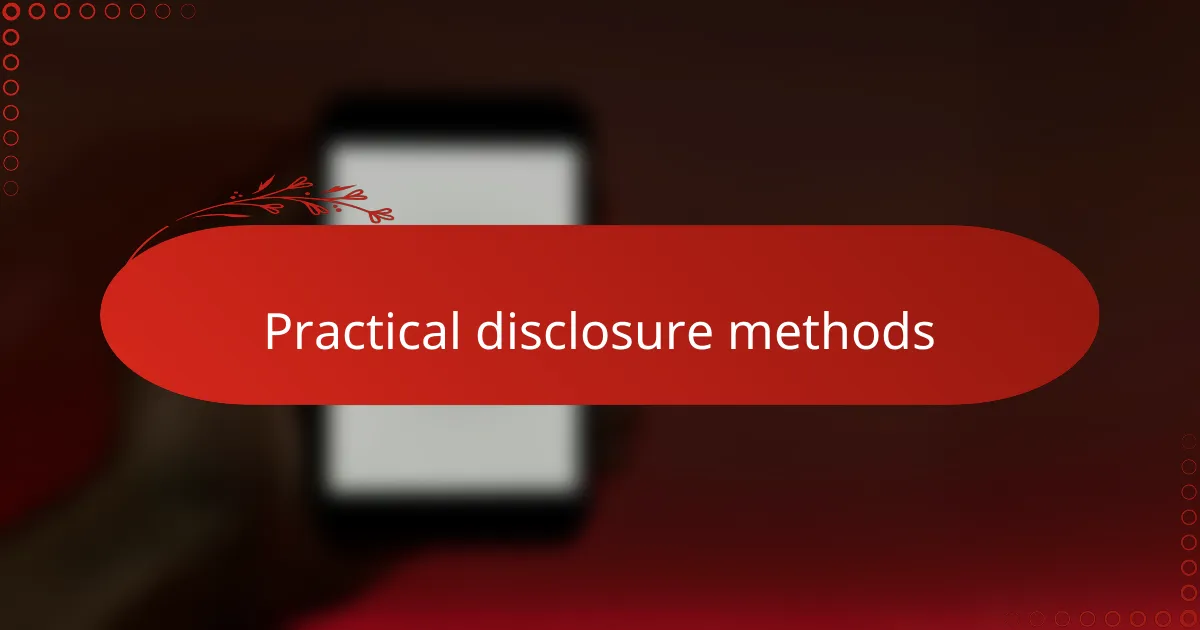
Practical disclosure methods
One practical method I’ve found effective is using clear verbal cues during the broadcast. For instance, simply stating, “This segment is sponsored by…” right before the content airs removes any guesswork for listeners. It’s straightforward and doesn’t interrupt the flow, but it sets the right expectation.
Another approach that worked well for me was integrating short, transparent announcements within the programming rather than at the start or end. This way, listeners don’t have to rely on remembering a single disclosure; they hear it naturally embedded in the show. Have you noticed how this subtle method keeps trust intact without feeling intrusive?
Sometimes, I’ve seen stations display on-screen text or provide disclaimers on their websites alongside live broadcasts. While this might feel like extra work, it complements the verbal disclosures and reaches listeners who might catch the show through digital platforms. From my perspective, combining several methods caters to different audience habits and strengthens overall transparency.
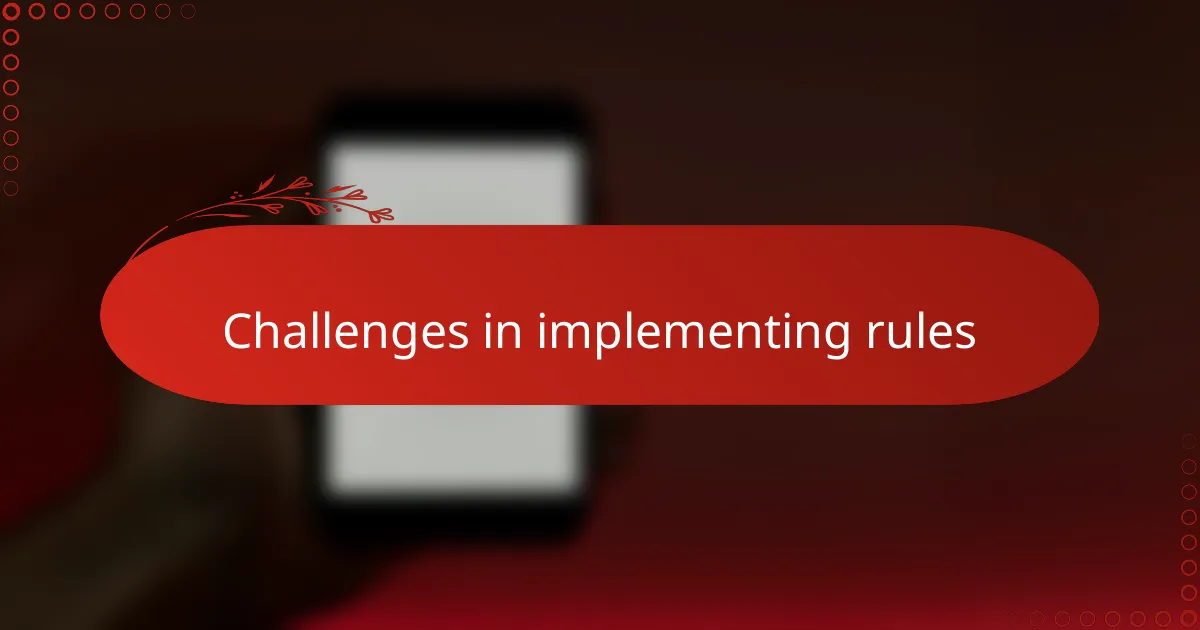
Challenges in implementing rules
Implementing content disclosure rules often feels like walking a tightrope. I’ve faced moments when trying to balance clear disclosure with keeping the broadcast engaging felt almost impossible. How do you stay transparent without making the show sound too formal or rigid? That tension is real and not easy to resolve.
Another challenge I’ve noticed is the inconsistency across stations and regions. Sometimes, the rules feel open to interpretation—what one broadcaster considers sufficient disclosure may seem vague to another. This ambiguity can cause confusion and hesitation, especially for those new to the industry.
Then there’s the technical side. In fast-paced live shows, slipping in disclosures at the right time without disrupting the flow can feel like a juggling act. I remember missing a crucial sponsor mention once, and the fallout was immediate. It taught me that practical hurdles are just as important as understanding the rules themselves.
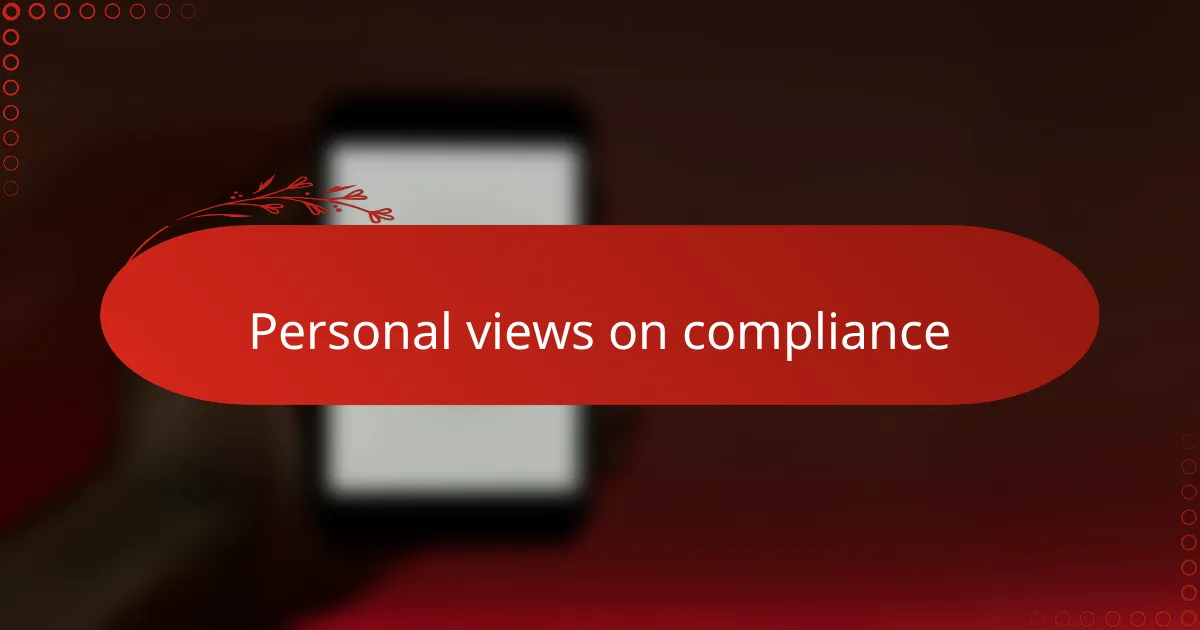
Personal views on compliance
Compliance with content disclosure rules, in my experience, often feels like a personal commitment rather than just a regulatory checkbox. Have you ever caught yourself double-checking a script, wondering if your phrasing truly meets both the letter and spirit of the rules? That careful attention comes from wanting to honor the listener’s trust, not simply to avoid penalties.
Sometimes, compliance can seem restrictive, almost like a cage around creativity. But I’ve found that embracing these boundaries actually sparks innovation—forcing me to think about fresh ways to communicate disclosures naturally and authentically. It’s a challenge, yes, but one that makes the broadcast better.
Of course, I won’t pretend compliance is effortless. There are moments when the pressure to keep ratings high clashes with the need for transparency. Yet, every time I prioritize disclosure, I feel a deeper connection with my audience, knowing I’m respecting their right to know. Isn’t that what good broadcasting is ultimately about?
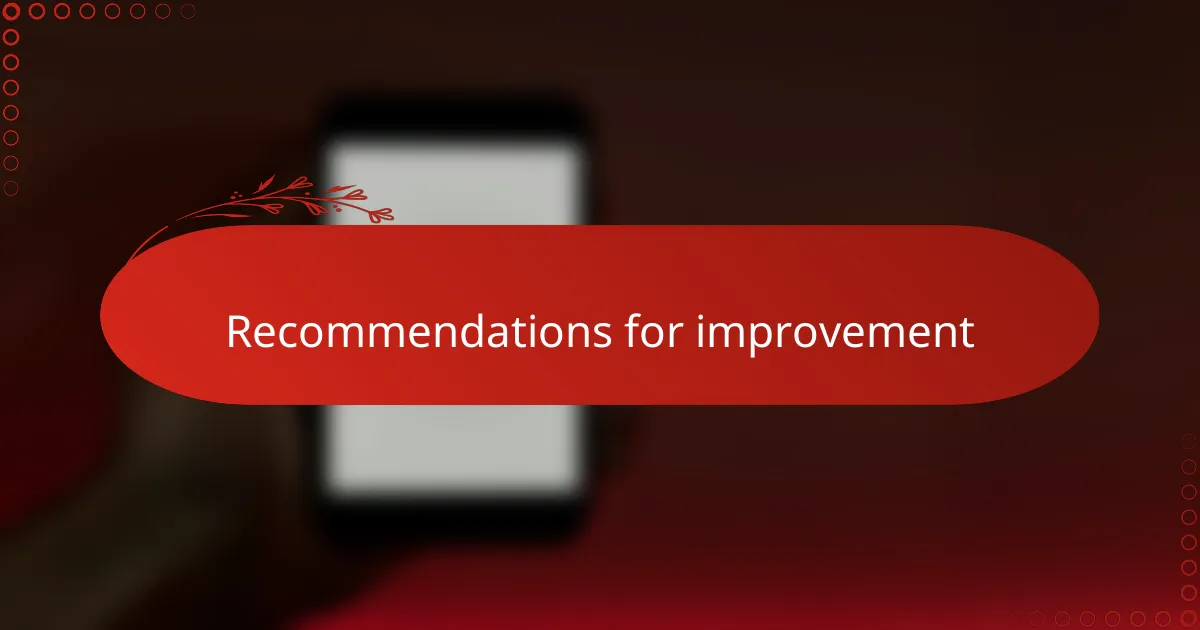
Recommendations for improvement
One recommendation I always come back to is training broadcasters more thoroughly on the nuances of disclosure. When I first started, I wished someone had walked me through practical scenarios rather than just handing me a list of rules. Wouldn’t it help if stations held regular workshops where hosts could practice clear, natural disclosure without feeling scripted? From what I’ve seen, hands-on learning creates confidence and reduces those awkward on-air moments.
I also believe standardizing certain disclosure phrases across the industry could make a big difference. Sometimes, I find myself wondering if my wording is transparent enough or if it sounds too rehearsed. If everyone used a few go-to expressions that audiences come to recognize, it could build trust faster and reduce confusion. Hasn’t it happened to you that a vague disclaimer left you scratching your head? Clear, consistent language could prevent that.
Finally, embracing new technology to support disclosures seems like an untapped opportunity. I’ve experimented with on-screen text during broadcasts and noticed listeners mentioning it in feedback—some said it made things “crystal clear.” Why not combine visual cues with verbal ones, especially for digital platforms? In my opinion, layered disclosure methods cater to diverse listeners and show a genuine commitment to transparency beyond just ticking legal boxes.
